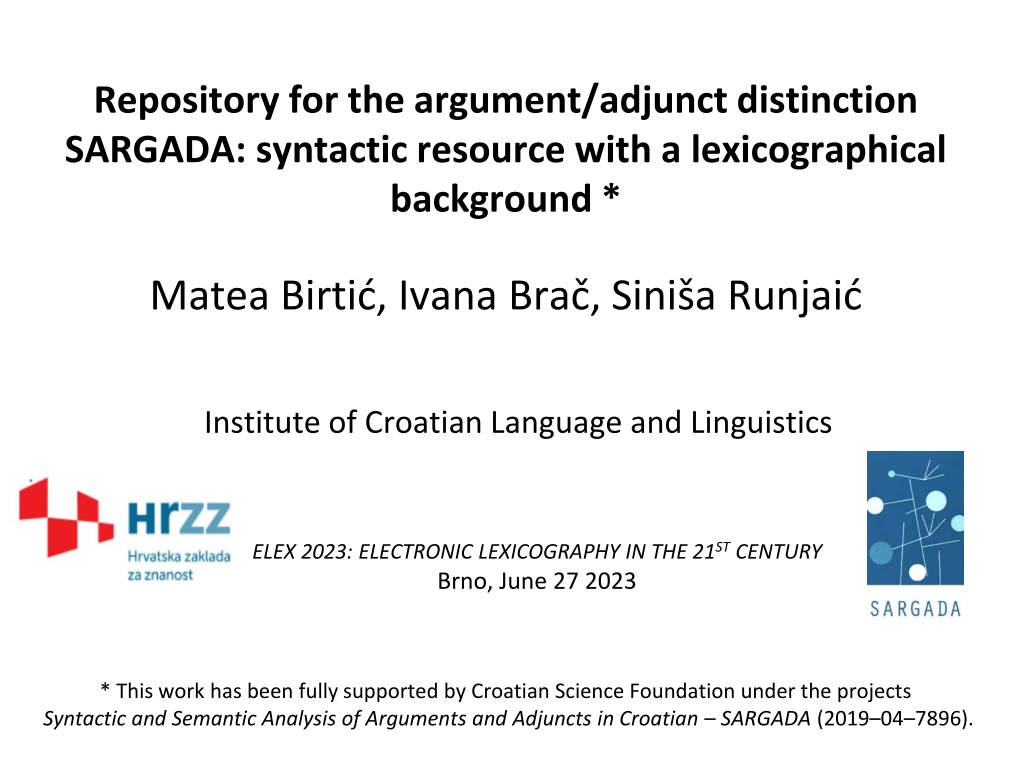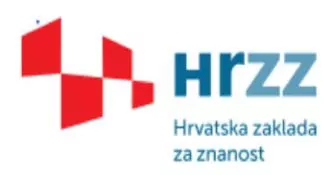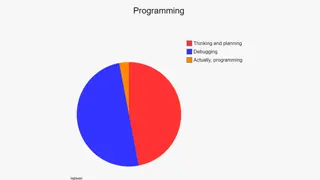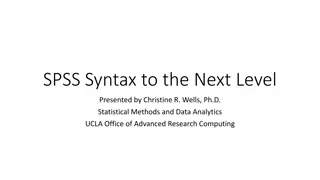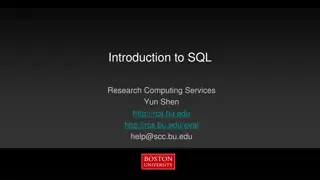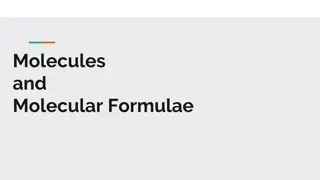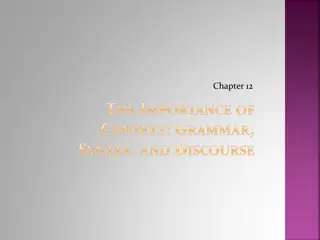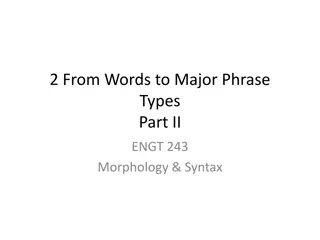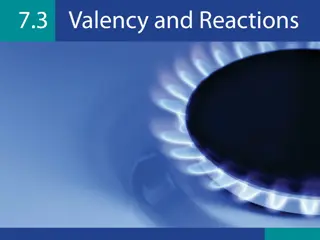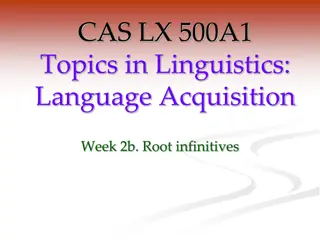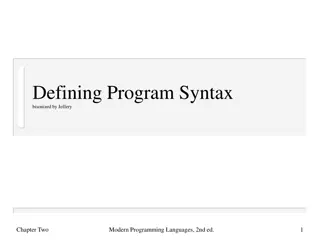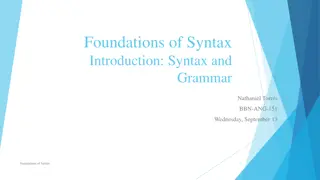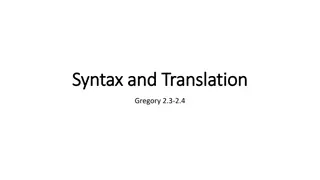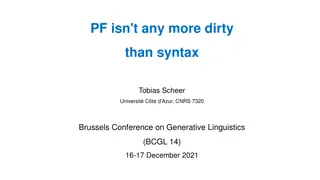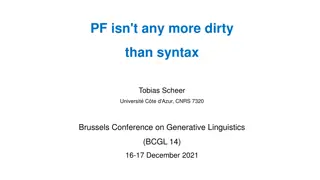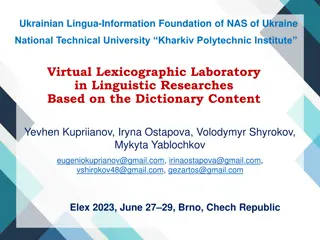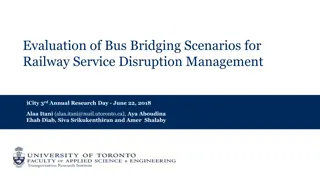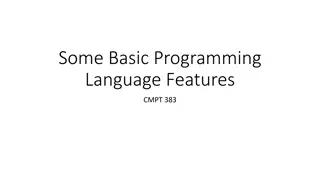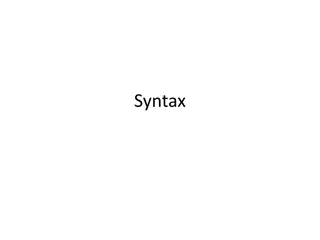Valency Lexicography and E-Glava: Bridging Syntax and Lexicography
Creating monolingual or multilingual dictionaries, especially valency lexicons, requires a deep understanding of grammatical phenomena across languages. Valency dictionaries provide not only lexical information but also syntactic structures of verbs and the semantic roles of their arguments. E-Glava, an online valency dictionary for Croatian verbs, exemplifies an approach that combines German valency theory with dependency grammar, focusing on the verb as the core of the sentence.
Download Presentation

Please find below an Image/Link to download the presentation.
The content on the website is provided AS IS for your information and personal use only. It may not be sold, licensed, or shared on other websites without obtaining consent from the author. Download presentation by click this link. If you encounter any issues during the download, it is possible that the publisher has removed the file from their server.
E N D
Presentation Transcript
Repository for the argument/adjunct distinction SARGADA: syntactic resource with a lexicographical background * Matea Birti , Ivana Bra , Sini a Runjai Institute of Croatian Language and Linguistics ELEX 2023: ELECTRONIC LEXICOGRAPHY IN THE 21STCENTURY Brno, June 27 2023 * This work has been fully supported by Croatian Science Foundation under the projects Syntactic and Semantic Analysis of Arguments and Adjuncts in Croatian SARGADA (2019 04 7896).
Short introduction creating an monolingual or multilingual dictionaries (along with lexicographic methodology) requires an authors' knowledge of certain grammatical phenomena of one or more languages while planning and organizing the creation of valency lexicon or dictionary, knowledge of certain grammatical phenomena is often more valuable than lexicographic theory and practices an indicatory case of a methodologies of lexicography and grammaticography because valency dictionaries are a type of resource that use both lexicographic and grammaticographic methods at the same time (provide grammatical properties of verb lemmas (such as their tense, aspect, and mood), but more importantly information on the syntactic structure of sentences that include the verbs, and information on the semantic roles of the arguments that a verb assigns. closer connection between
E-Glava: online valency dictionary Croatian online verb valency dictionary http://valencije.ihjj.hr/ Part of the Institute of Croatian Language and Linguistics internal project: Valency base of Croatian verbs List of 900 most frequent Croatian verbs (B1 CEFR) classified into 34 semantic groups according to Levin (1993) first semantic group (finished): psych-verbs syntactic alternations in the same semantic class [Njihov dolazakNOM]CAUraduje [gradACC]EXP. His arrival rejoices the city. [GradNOM]EXPse raduje [njihovu dolaskuDAT]CAU The city rejoices in his arrival. In details: 2017. Birti , Matea, Ivana Bra , Sini a Runjai . The Main Features of the e-Glava Online Valency Dictionary. // Electronic lexicography in the 21stcentury. Proceedings of eLex 2017 conference. Leiden, the Netherlands, 19 21 September 2017. / ed. Iztok Kosem et al. Leiden: Lexical Computing CZ s.r.o., Brno, Czech Republic, 2017. Pp. 43 62.
E-Glava: approach to valency based on the German approach to valency: VALBU (Schumacher et al. 2004) and E-VALBU verb the center of the sentence, dependency grammar verb valency number and types of arguments a verb requires; a verb s capacity to combine with other elements
From Tscwanelex to e-Glava output (57 verb lemmas, 187 meanings and 375 valency patterns) Tschwanelex DTD (editing) PostgreSQL database Native XML (complete lemmas) PHP admin + HTML 5 coding E-Glava output
Example: are some dependents non-obligatory arguments or adjuncts??
Project SARGADA Syntactic and Semantic Analysis of Arguments and Adjuncts in Croatian - SARGADA aims: theoretical research of the distinction between arguments and adjuncts within three theoretical frameworks valency theory and dependency grammar cognitive grammar generative grammar syntactic repository containing sentences with ambiguous syntactic parts regarding argument/adjunct distinction
SARGADA Repository: goal and project planning Goal: building the repository of sentences in Croatian with ambiguous phrases regarding the argument/adjunct status Plan: The repository is grounded on the computational database whose building encompasses several methodological steps (4 years span): the design of the specific relational database in SQL environment on server infrastructure year 1 personalized input interface for project members year 2 setting of a stable working version with sentence descriptions (with the relevant central content management system - CMS) year 3 revision and organization of data for the opening for the public and adding additional user functions year 4
Project SARGADA: lemmas and macrogroups 1. Lemmas: list of 130 verbs/lemmas with ambiguous syntactic parts regarding argument/adjunct distinction. 2. Classification:
SARGADA Repository: tagging model for examples We have chosen 12 tags (basic syntactic model) for tagging sentence structure: definite tags for unquestionable elements, i.e. the tag 'test' for a sentence elements that can be either arguments or adjuncts. (Argument) Subject: tag Argument_S (Argument) Direct object: tag Argument_DO (Argument) Indirect object : tag Argument_IO (Argument) Prepositional phrase: tag Argument_PP Adjunct: tag Adjunct Verb: tag Verb Adverb: tag Adverb Reflexivity: tag Refl Auxilary verb: tag Aux Conjuction: tag Conj Negation: tag Neg Tested sentence part: tag TEST 1. 2. 3. 4. 5. 6. 7. 8. 9. 10. 11. 12.
Diagnostics for argument/adjunct distinction 1. Omission test 2. Implication test 3. Do so test 4. This happened test 5. Replacement test 6. Substitution test 7. Dialogue test the tests from dependency grammar and generative grammar are employed in repository
1. Omission test optionality test (Toivonen 2011), Eliminierungs test (Helbig & Schenkel 1978), Reduktionstest (Engel 2009) separation of obligatory elements from non-obligatory elements if a syntactic phrase can be omitted, and the sentence remains grammatical, the omitted part is not an obligatory argument, but an optional argument or an adjunct Dje ak baca kamenje (u vodu). (1) boy throws stones into water.ACC.SG A boy throws stones (into the water). Moj ro ak boravi (*u Chicagu). (2) my cousin is-staying in Chicago. LOC.SG My cousin is staying (*in Chicago.) problem: arguments can be omitted (eat, read, sing) and some adjuncts are obligatory (by-phrases)
2. Implication test Folgerungstest, Core Participant Test if a verb presupposes the appearance of an entity, then we are dealing with an argument is there always a presupposed place where the stone has been thrown replace the imagined part by a pronoun/adverb (3) and the pronoun/adverb cannot be negated (4) Dje ak baca kamen nekamo. (3) boy throws stone somewhere A boy throws a stone somewhere. anaphorisation (DP) #Dje ak baca kamen nekamo, ali nekamo ne postoji. (4) boy throws stone somewhere but somewhere NEG exists #A boy throws a stone somewhere, but somewhere does not exist. dialogue test used for the optional arguments used for non-stative verbs
3. Do so test Lakoff and Ross 1966 nonstative verb + its argument(s) = do so (5) Harry forged a check, but Bill could never bring himself to do so. elements after do so outside the verb phrase adjuncts (6) John took a trip last Tuesday, and I m going to do so tomorrow. (7) The army destroys villages with shells, but the airforce does so with napalm. direct objects, indirect objects, directional adverbs, affected locatives arguments time, place, manner, duration, frequency, instruments, comitative adjuncts
4. This happened test Brown and Miller 1991 if a sentence can be paraphrased by two sentences, one contains the nuclear predications and the other adverbial (8) John stood on the table. This happened in the bathroom. (9) *John stood. This happened on the table. used for non-stative verbs
5. Replacement test Ersatzprobe, Kommutations test ( gel 2000) arguments are selected by a verb, while adjuncts are not If the replacement of a phrase with the different morphological form is possible the phrase is an adjunct if the replacement is not possible the phrase is an argument 10) Brat je bacio kamen u vodu / na krov / preko ku e. brother AUX threw stone into water.ACC.SG onto roof.ACC.SG over house.GEN.SG The brother threw a stone into the water/onto the roof/ over the house. 11) Jezik je proistekao iz naroda *na narod / *preko naroda. language AUX arose from people.GEN.SG onto people.ACC.SG over people.GEN.SG The language arose from the people / *onto the people / *over the people.
6. Substitution test Substitutionstest ( gel 2000), Supklassentest (Engel 2009) substitution test examines the verb specificity (Subklassenspezifik, subcategorization) if the verb next to a syntactic phrase can be replaced by another verb, then the phrase is an adjunct ( gel 2000, ojat 2008) 12) Brat je bacio/ gurnuo / izbacio/ zavitlao / *razveselio se /*pojeo /*sje ao se kamen u vodu. 13) The brother threw / pushed / ejected / swirled / *cheered /*ate/ *remembered a stone into the water.
7. Dialogue test Functional Generative Description framework (Panenova 1974, Sgall 1978) for the arguments that are not realized at the surface, information about them has to be present in the speaker s mind A: Dinara le i na granici izme u Hrvatske i BiH. Dinara lies on the border between Croatia and BiH. B: Gdje Dinara le i? Where does Dinara lie? A: #Ne znam. I don t know.
Technical details and preliminary results a subdomain http://ihjj.hr/sargada/ has been created the Ubuntu 18 server operating system with LAMP architecture (Linux, Apache, MySQL and PHP) has been successfully installed and configured for the server infrastructure. structure (according to our initial design) - HTML; markup language used for structuring and presenting content development (logical structure) - Javascript, i.e. Vue.js framework for building user interfaces visual presentation - Cascading Style Sheets (CSS); style sheet language for describing the presentation of a document written in a HTML.
Interface 2 (example: boraviti stay) Note: The happened applicable because the tested sentence part is following the stative verb boraviti 'to stay'. Do so test and are This not test the morphological form of an argument is dictated by a verb, and the morphological form of an adjunct is not (traces back to Tesni re) if the verb next to a syntactic phrase can be replaced by another verb, then the phrase is an adjunct
sluiti serve Vozilo VehicleNom.sg "The vehicle is used to transport things." slu i za prijevoz stvari. serve3.sg to transportAcc.SgthingsAcc.Pl Vozilo VehicleNom.sg "The vehicle is used to transport things. slu i prijevozu stvari. serve3.sg transportDat.Sg thingsGen.Pl (Vozilo slu i da se prevezu stvari.) Vozilo VehicleNom.sg thingsGen.Pl The vehicle serves a person to transport things. slu i ovjeku za prijevoz stvari. serve3.sg manDat.Sg to transportAcc.Sg * Vozilo * VehicleNom.sg slu i serve3.sg ovjeku manDat.Sg prijevozu stvari. transportDat.SgthingsGen.Pl
Thank you for your attention! mbirtic@ihjj.hr ibrac@ihjj.hr srunjaic@ihjj.hr
